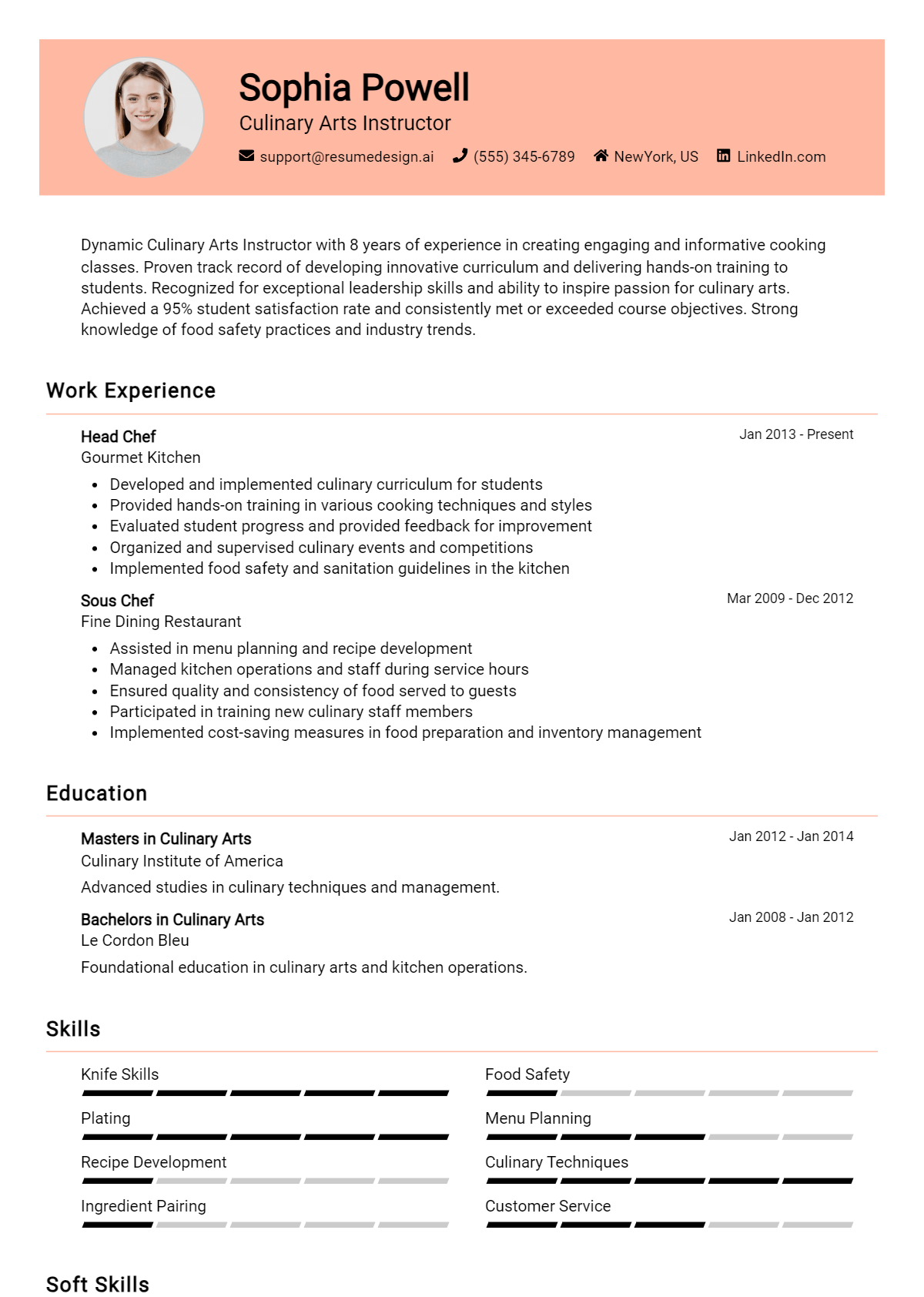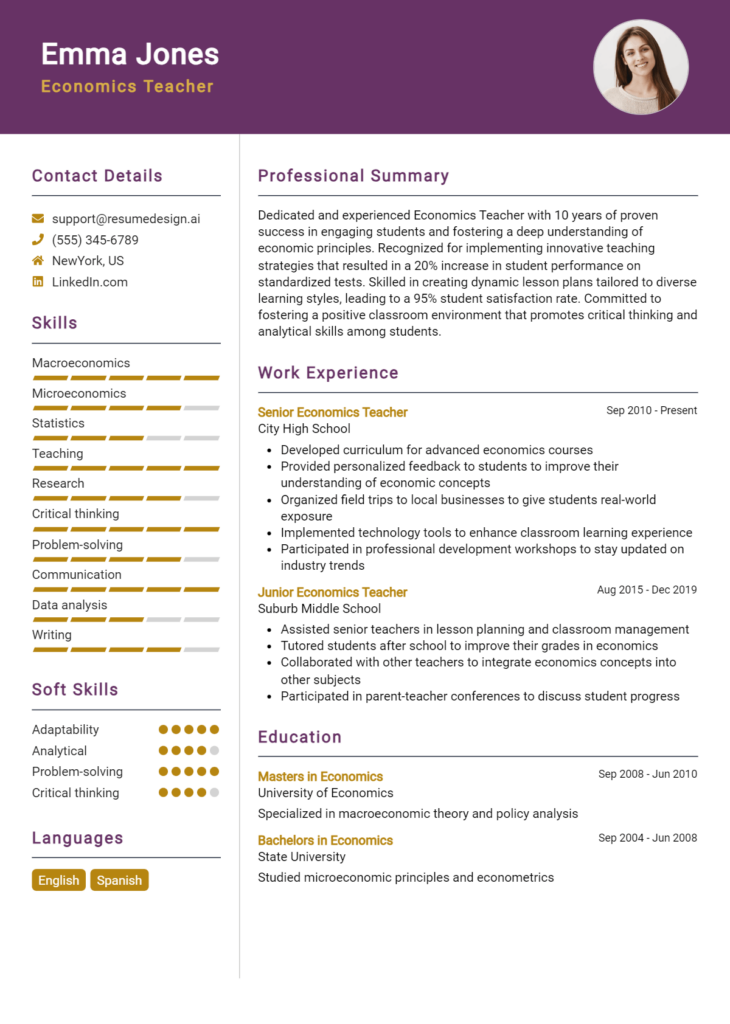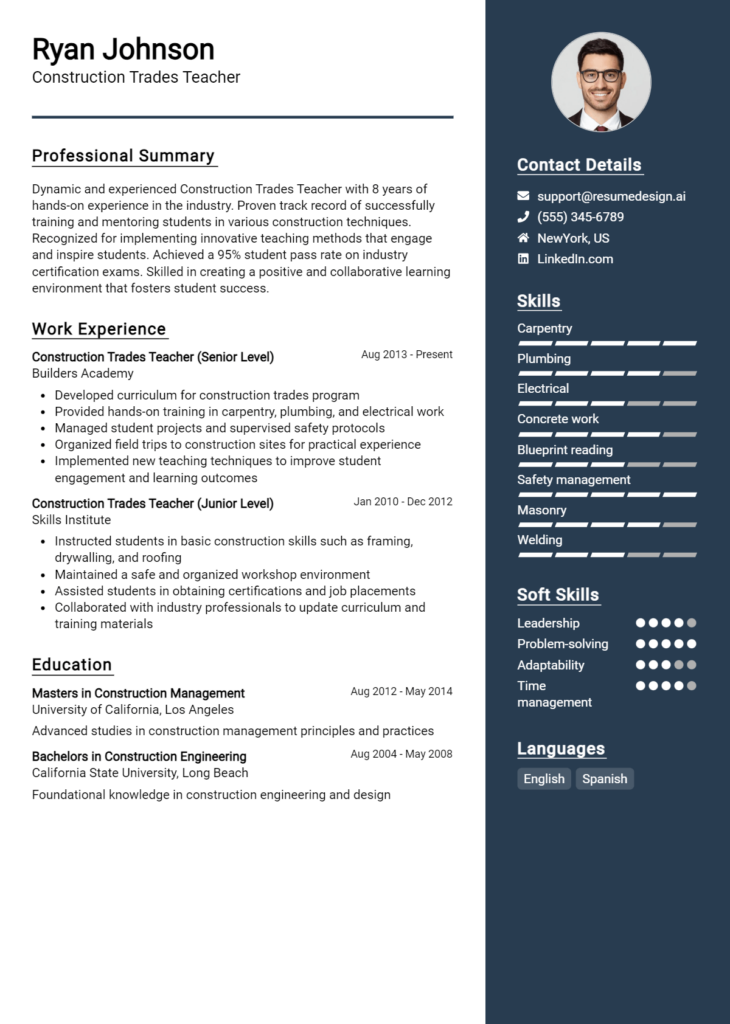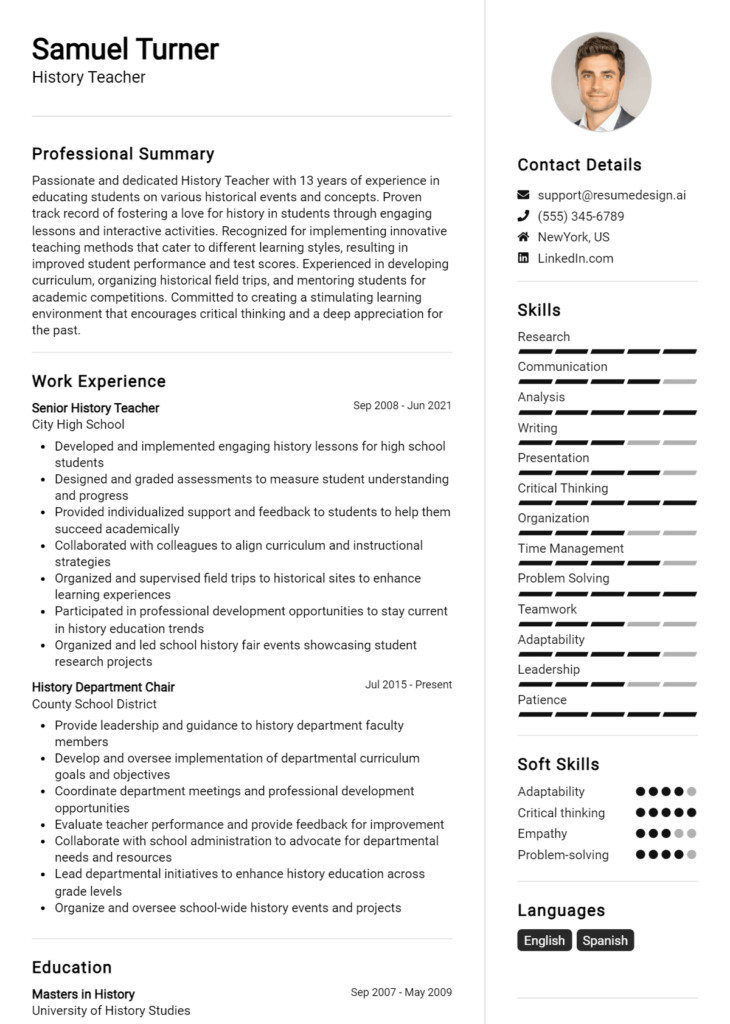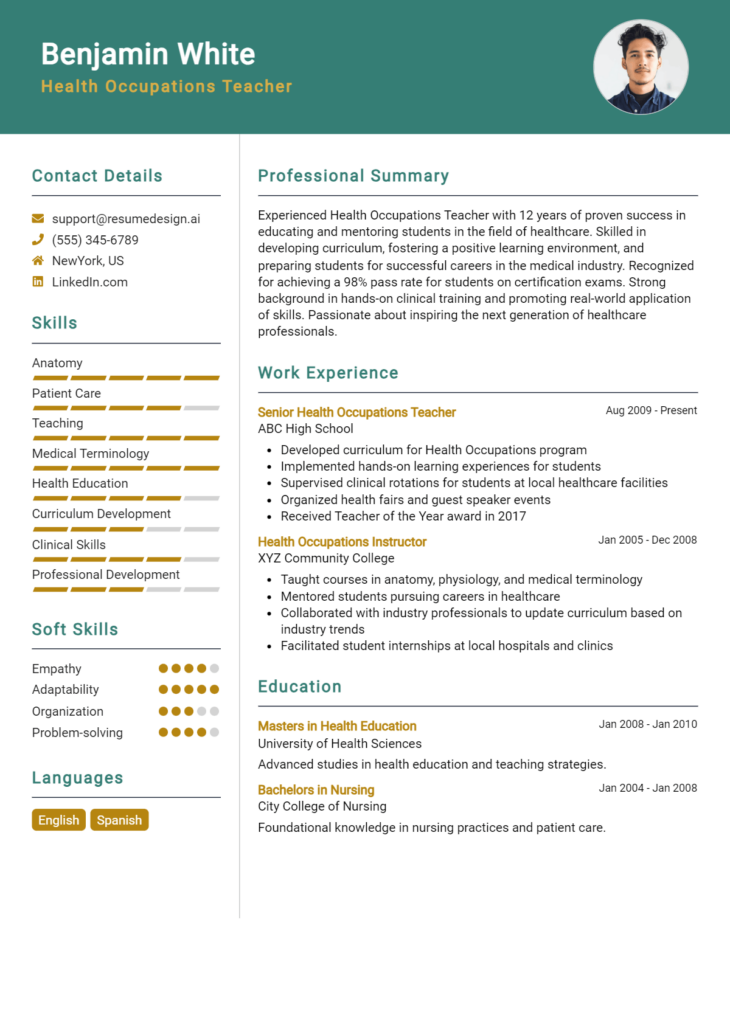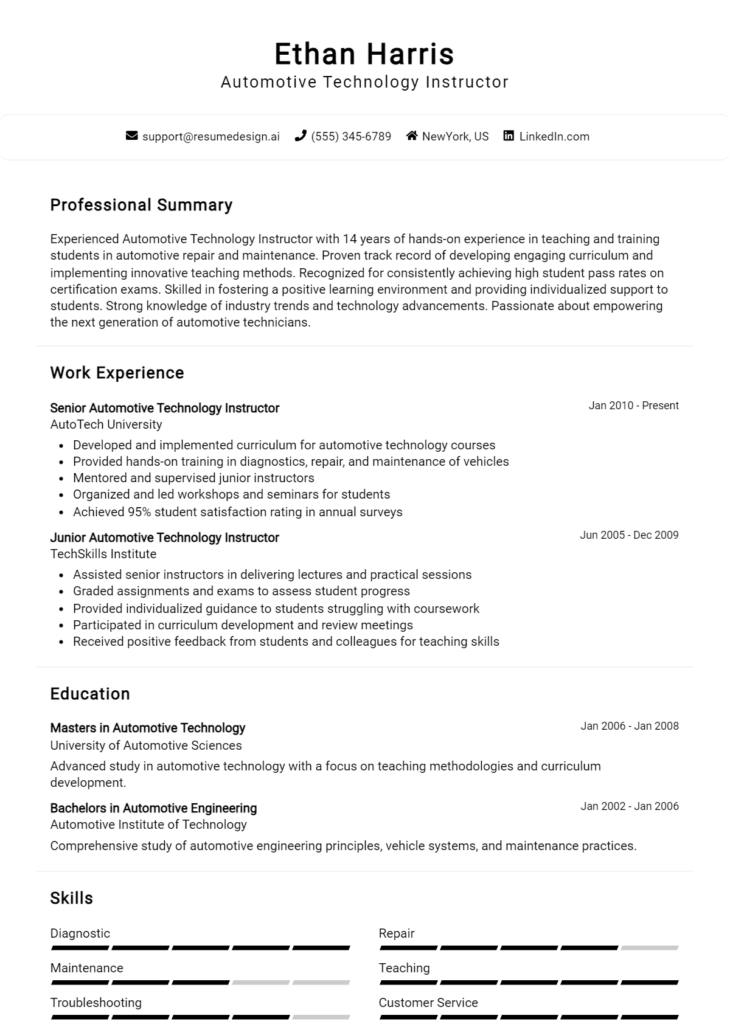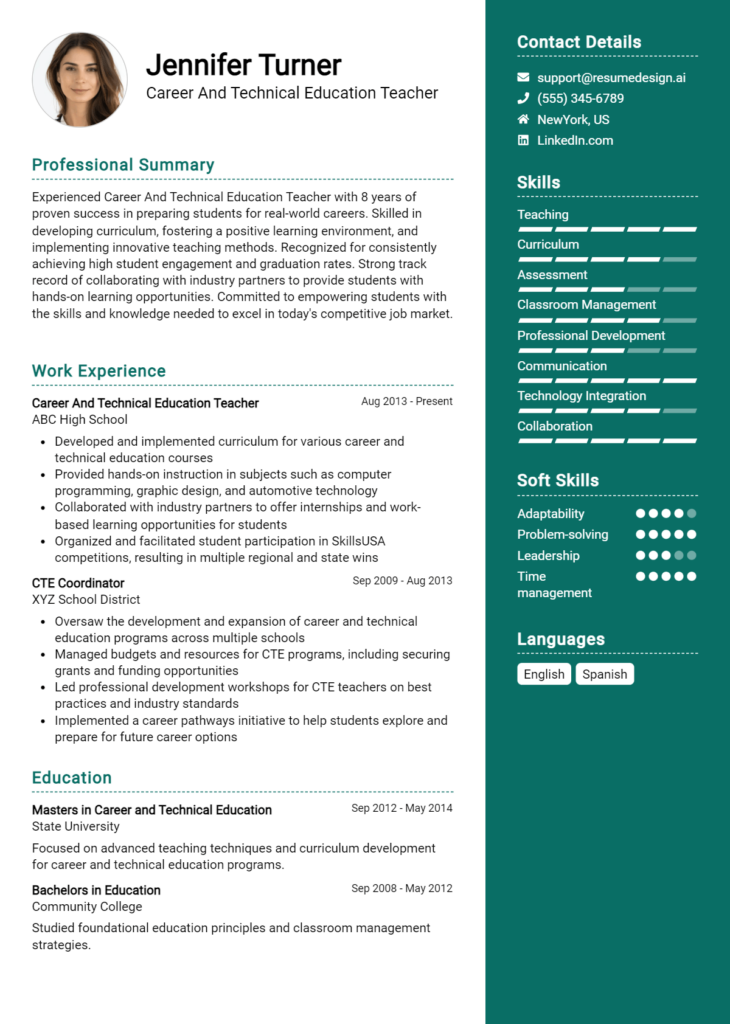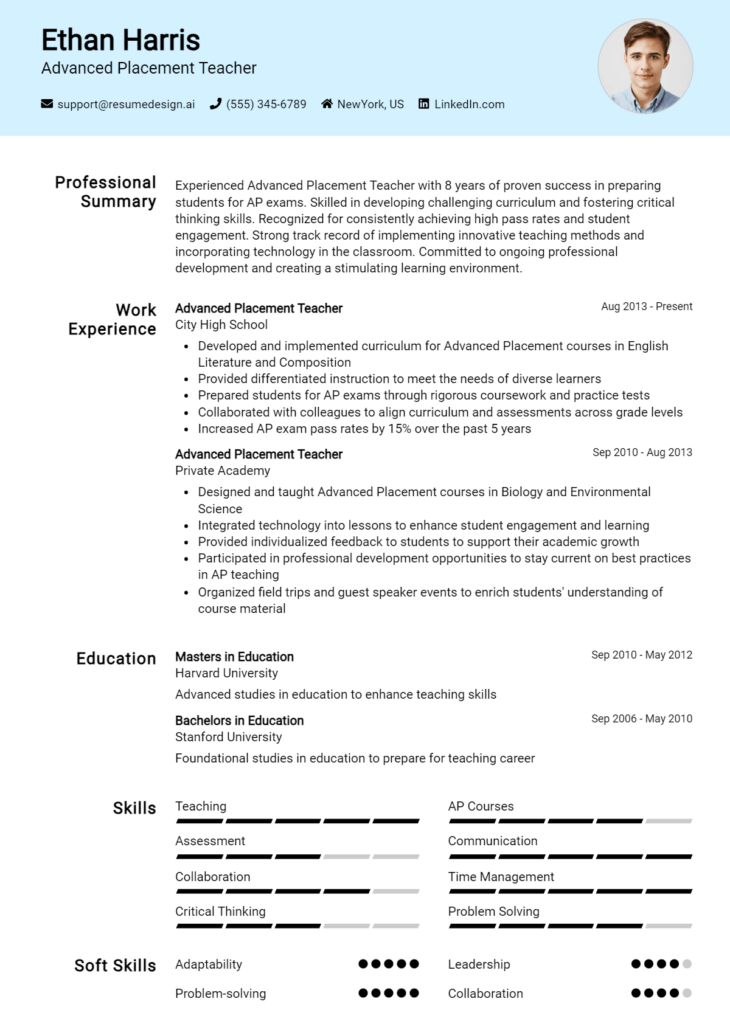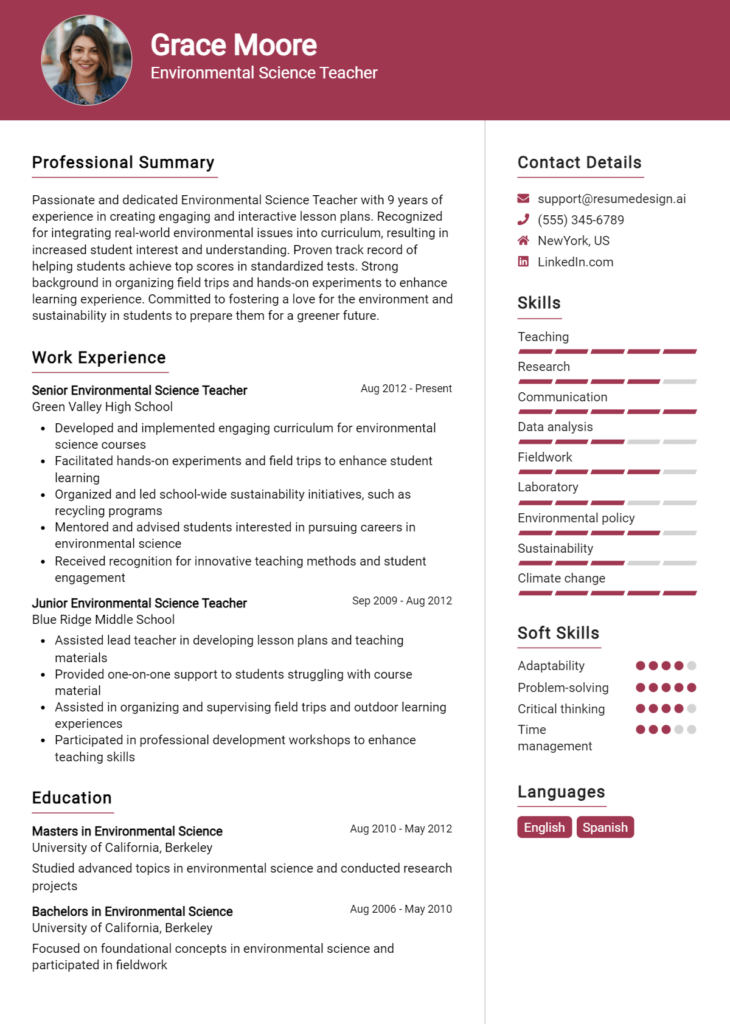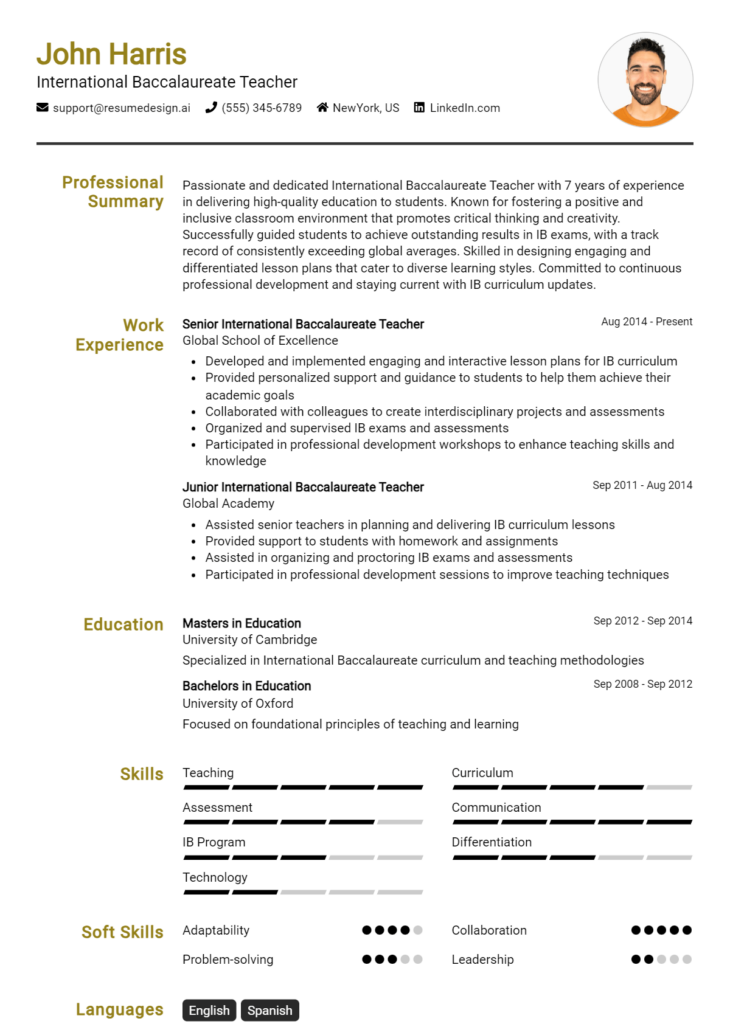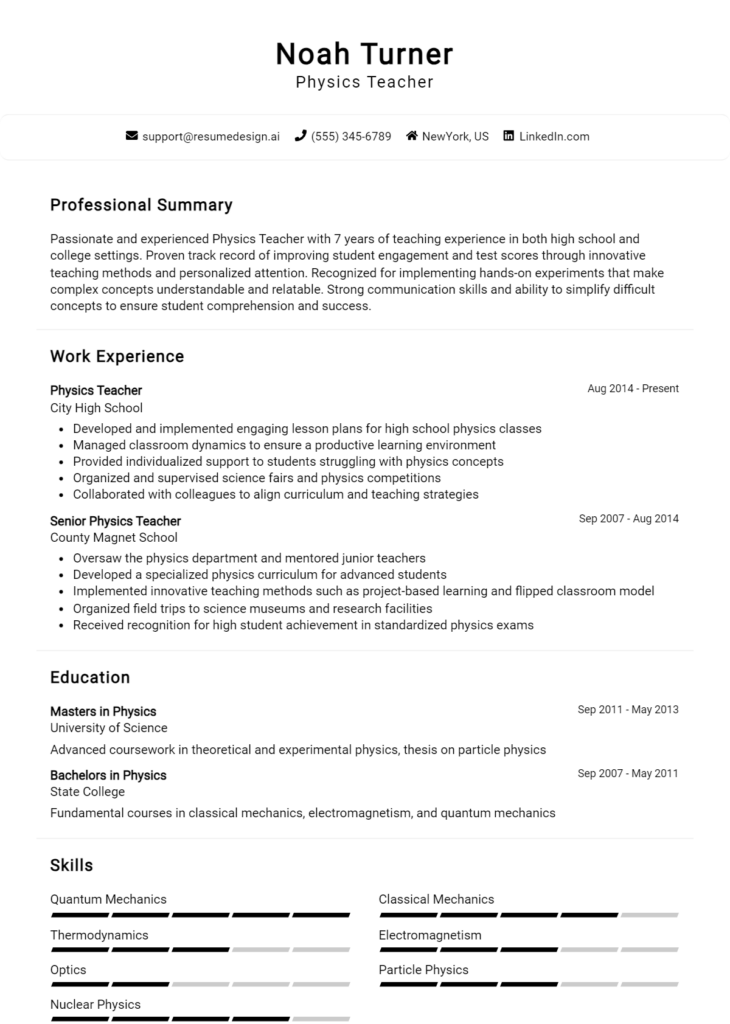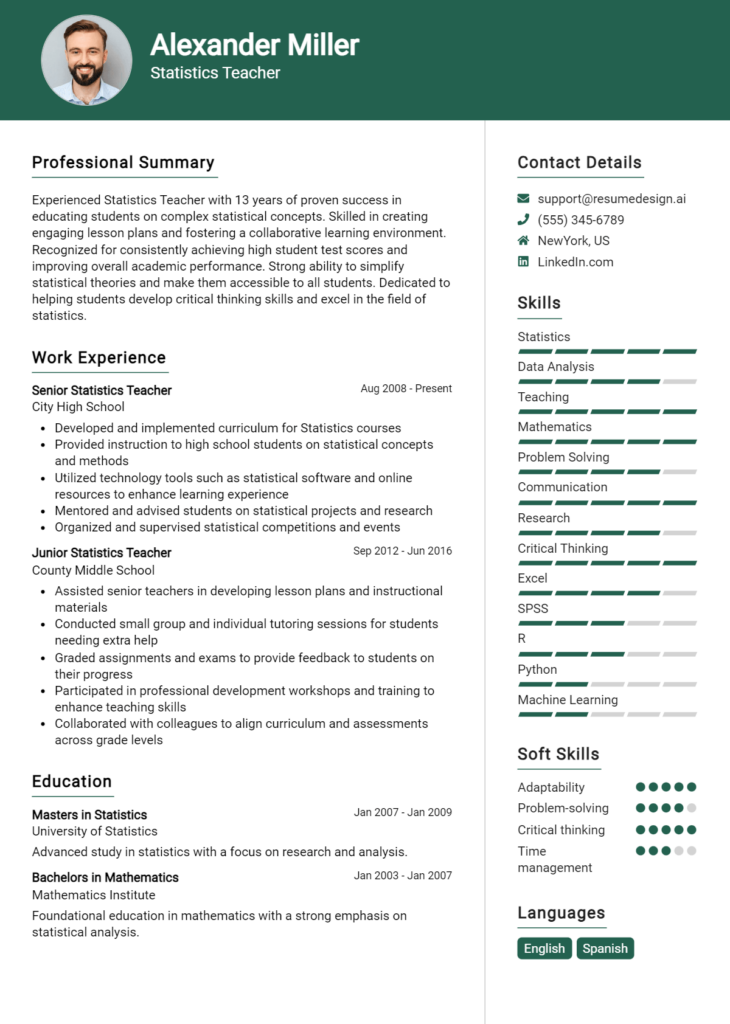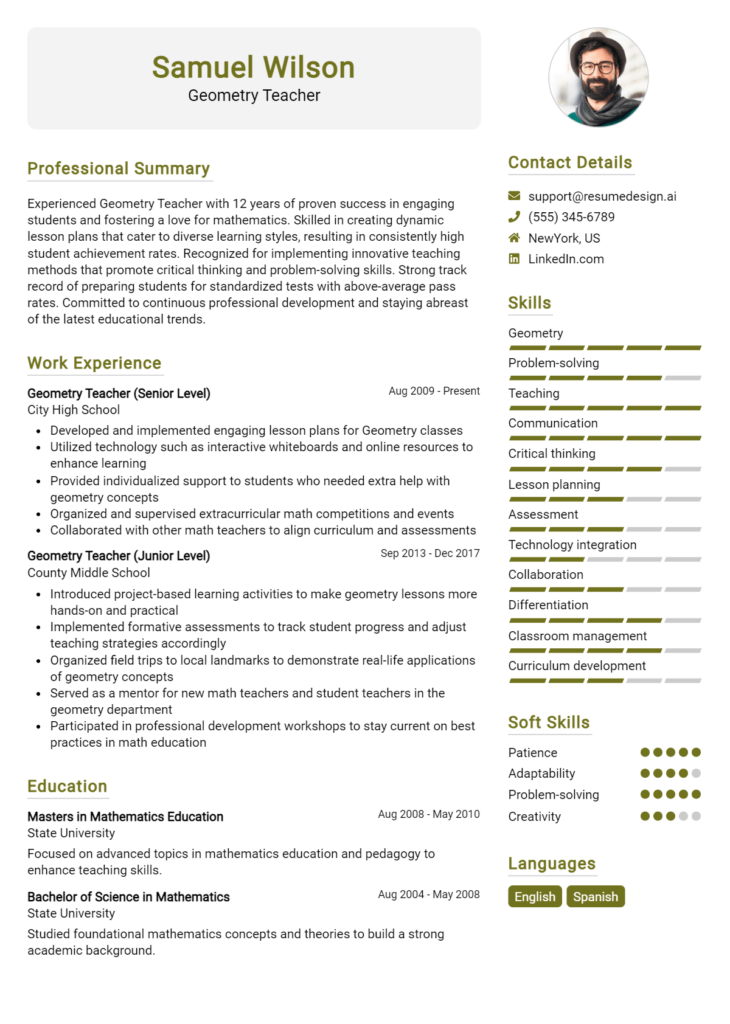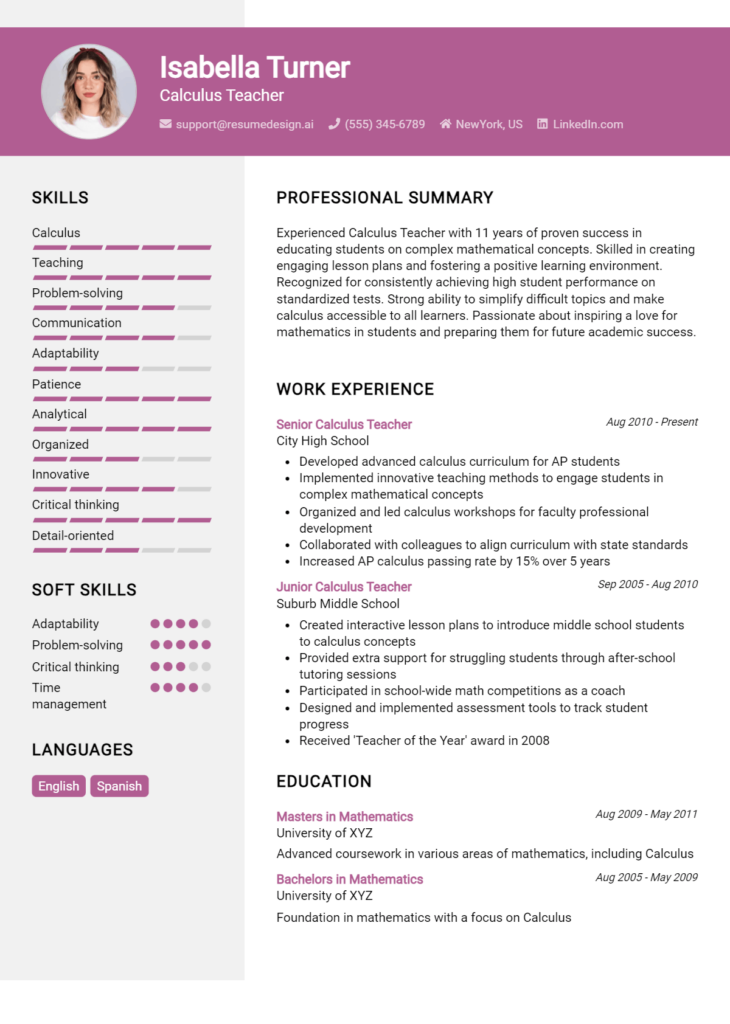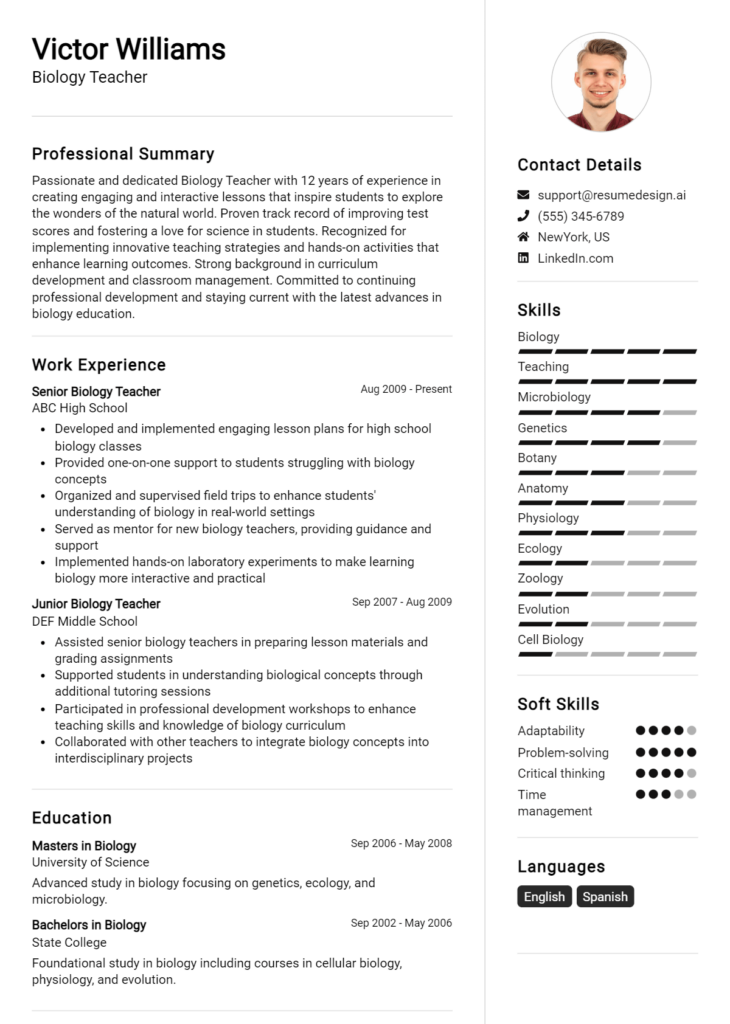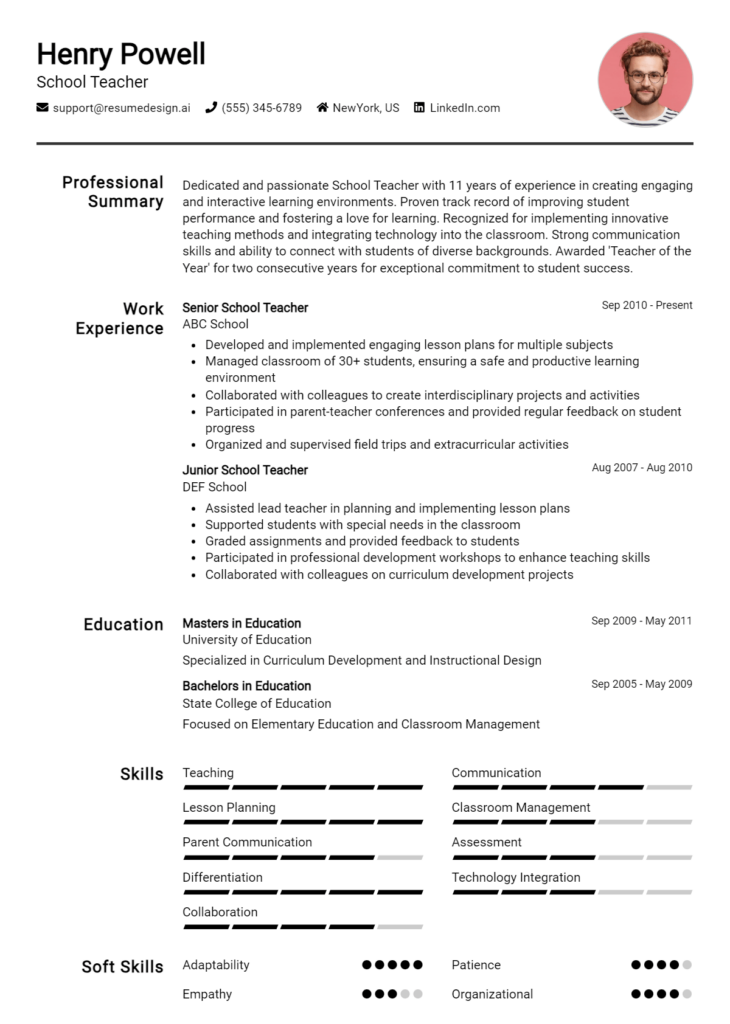Culinary Arts Instructor Core Responsibilities
A Culinary Arts Instructor plays a crucial role in shaping future chefs by developing and delivering engaging curriculum, demonstrating culinary techniques, and evaluating student progress. This position requires a combination of technical expertise, operational knowledge, and strong problem-solving skills to effectively bridge the gap between culinary theory and practical application. These competencies not only enhance student learning but also align with the organization's educational goals. A well-structured resume can effectively highlight these qualifications, showcasing the instructor's ability to inspire and lead in a dynamic kitchen environment.
Common Responsibilities Listed on Culinary Arts Instructor Resume
- Develop and implement culinary curriculum and lesson plans.
- Conduct hands-on cooking demonstrations and workshops.
- Assess and evaluate student performance and progress.
- Provide constructive feedback and mentorship to students.
- Ensure adherence to food safety and sanitation standards.
- Collaborate with other departments on interdisciplinary projects.
- Organize and participate in culinary competitions and events.
- Stay updated on industry trends and best practices.
- Manage kitchen inventory and supplies efficiently.
- Foster a positive and inclusive learning environment.
- Utilize technology for teaching and administrative tasks.
- Conduct research to enhance culinary education practices.
High-Level Resume Tips for Culinary Arts Instructor Professionals
In the competitive field of culinary arts, a well-crafted resume is crucial for aspiring Culinary Arts Instructors. This document often serves as the first impression a candidate makes on a potential employer, and it needs to effectively showcase both skills and achievements. A strong resume not only highlights culinary expertise but also demonstrates teaching abilities, creativity, and passion for the culinary arts. This guide will provide practical and actionable resume tips specifically tailored for Culinary Arts Instructor professionals to help you stand out in this vibrant industry.
Top Resume Tips for Culinary Arts Instructor Professionals
- Tailor your resume to each job application by aligning your skills and experience with the specific requirements outlined in the job description.
- Showcase relevant teaching experience, including any previous positions held in educational institutions, culinary schools, or workshops.
- Quantify your achievements where possible, such as the number of students taught, curriculum developed, or improvements in student performance.
- Highlight industry-specific skills like menu planning, food safety, culinary techniques, and knowledge of diverse cuisines.
- Include certifications or degrees relevant to culinary arts and education, such as a Culinary Arts degree or teaching credentials.
- Incorporate keywords from the job posting to pass through Applicant Tracking Systems (ATS) and catch the attention of recruiters.
- Demonstrate your creativity by including any unique teaching methods or innovative culinary projects you’ve implemented.
- Use a clean and professional format, ensuring that your resume is easy to read and visually appealing.
- Consider adding a brief personal statement or summary at the top of your resume to concisely convey your career goals and teaching philosophy.
By implementing these tips, Culinary Arts Instructor professionals can significantly increase their chances of landing a job in this dynamic field. A well-structured resume that effectively highlights relevant experience and achievements not only grabs the attention of hiring managers but also sets the candidate apart in a crowded job market. Your resume is your culinary calling card—make it memorable!
Why Resume Headlines & Titles are Important for Culinary Arts Instructor
In the competitive field of culinary education, a well-crafted resume headline or title serves as a vital first impression for a Culinary Arts Instructor. A strong headline can immediately grab the attention of hiring managers, effectively summarizing a candidate's key qualifications in just a few impactful words. This succinct yet powerful phrase should be concise, relevant, and directly related to the specific position being applied for, as it sets the tone for the rest of the application and highlights the applicant's unique strengths and experiences.
Best Practices for Crafting Resume Headlines for Culinary Arts Instructor
- Keep it concise: Aim for one to two impactful phrases.
- Be role-specific: Tailor your headline to align with the Culinary Arts Instructor position.
- Highlight key qualifications: Use strong adjectives that showcase your expertise.
- Include relevant skills: Mention culinary techniques or teaching methods that stand out.
- Use industry keywords: Incorporate terminology that resonates with culinary education and job descriptions.
- Avoid jargon: Keep the language clear and accessible for all readers.
- Showcase achievements: If possible, reference notable accomplishments or certifications.
- Stay professional: Ensure the tone reflects your professionalism and passion for culinary arts.
Example Resume Headlines for Culinary Arts Instructor
Strong Resume Headlines
Innovative Culinary Arts Instructor with 10+ Years of Experience in Fine Dining and Education
Passionate Culinary Educator Skilled in Curriculum Development and Student Engagement
Certified Executive Chef with Proven Track Record in Training Future Culinary Leaders
Dynamic Culinary Instructor Specializing in Contemporary Techniques and Traditional Cuisine
Weak Resume Headlines
Culinary Arts Instructor Looking for a Job
Experienced Chef
Teaching Culinary Skills
The strong headlines are effective because they not only convey the candidate's key strengths and relevant experience but also capture the essence of what makes them a valuable asset to potential employers. They utilize industry-specific language and highlight specific qualifications, ensuring that the hiring manager sees the applicant as a suitable fit for the role. In contrast, the weak headlines fail to impress due to their vagueness and lack of specificity, offering no insight into the candidate's unique qualifications or expertise. They do not provide a compelling reason for hiring managers to consider the applicant seriously, which could hinder their chances of moving forward in the selection process.
Writing an Exceptional Culinary Arts Instructor Resume Summary
A resume summary is a crucial element for a Culinary Arts Instructor as it serves as the first impression to hiring managers, offering a concise overview of the candidate's qualifications. A strong summary quickly captures attention by highlighting key skills, relevant experience, and notable accomplishments that align with the specific job role. It should be crafted to be both impactful and tailored, ensuring that it resonates with the expectations of the culinary education sector. A well-written summary can differentiate a candidate in a competitive job market, making it essential for aspiring instructors to invest time in perfecting this section of their resume.
Best Practices for Writing a Culinary Arts Instructor Resume Summary
- Quantify Achievements: Use numbers and specific metrics to illustrate your impact, such as the number of students mentored or courses developed.
- Highlight Relevant Skills: Focus on culinary techniques, teaching methods, and classroom management skills that are directly applicable to the role.
- Tailor for the Job Description: Customize your summary to reflect the specific requirements and expectations outlined in the job listing.
- Be Concise: Aim for 3-5 sentences that effectively summarize your qualifications without overwhelming the reader.
- Use Action Verbs: Begin sentences with dynamic verbs that convey your contributions and achievements to make your summary more engaging.
- Showcase Passion for Teaching: Reflect your enthusiasm for culinary arts and education, indicating your dedication to student success.
- Include Certifications: Mention relevant certifications or degrees that reinforce your expertise and credibility as an instructor.
Example Culinary Arts Instructor Resume Summaries
Strong Resume Summaries
Dynamic Culinary Arts Instructor with over 10 years of experience in teaching diverse culinary techniques to students of all levels. Successfully increased student pass rates by 30% through the implementation of innovative teaching methods and hands-on practical sessions.
Passionate Culinary Arts Educator skilled in creating engaging curriculum focused on sustainability and international cuisines. Developed a farm-to-table program that enhanced student understanding of local sourcing, resulting in a 25% increase in student engagement ratings.
Experienced Culinary Instructor adept at fostering a collaborative learning environment. Led a team of 5 instructors to design a comprehensive culinary program that received accreditation and increased enrollment by 40% within two years.
Weak Resume Summaries
Culinary Arts Instructor with experience in teaching cooking classes and preparing students for the industry.
I am passionate about cooking and teaching others about food. I have worked in various culinary settings and enjoy sharing my knowledge.
The strong resume summaries are considered effective because they include quantifiable results, specific skills, and a clear connection to the role of a Culinary Arts Instructor. They paint a vivid picture of the candidate's impact and expertise. In contrast, the weak summaries lack detail and specificity, making them vague and generic, which fails to engage hiring managers or convey the candidate's true potential in a competitive culinary education landscape.
Work Experience Section for Culinary Arts Instructor Resume
The work experience section of a Culinary Arts Instructor resume is crucial as it serves as a platform for candidates to highlight their technical skills, leadership qualities, and ability to deliver high-quality culinary products. This section not only showcases the candidate's hands-on experience in the culinary field but also illustrates their capacity to manage teams effectively, mentor students, and contribute to an institution's overall success. Quantifying achievements—such as improved student performance, increased enrollment numbers, or successful event execution—can significantly strengthen this section. Additionally, aligning work experiences with industry standards ensures that the candidate's qualifications resonate with potential employers.
Best Practices for Culinary Arts Instructor Work Experience
- Detail specific culinary skills and techniques mastered, such as knife skills, baking, or food safety protocols.
- Include quantifiable achievements, such as the percentage increase in student engagement or external culinary competition wins.
- Highlight leadership roles, such as managing a kitchen brigade or leading a curriculum development team.
- Showcase collaborations with local businesses or organizations to enhance student learning experiences.
- Emphasize innovative teaching methods or course improvements that led to enhanced student satisfaction.
- Document any certifications or continuous education that align with current culinary trends.
- Use active verbs to convey a sense of initiative and impact, such as "developed," "implemented," or "led."
- Tailor experiences to reflect the specific requirements and culture of the institution you are applying to.
Example Work Experiences for Culinary Arts Instructor
Strong Experiences
- Developed and implemented a new farm-to-table curriculum that increased student enrollment by 30% over two semesters.
- Led a team of 10 students in a culinary competition, resulting in a first-place finish and media coverage in local publications.
- Created a partnership with a local restaurant that provided 50 hours of real-world kitchen experience for students each semester.
- Enhanced the baking program by introducing a new pastry module, which improved student performance by 25% as measured by final assessments.
Weak Experiences
- Taught various cooking classes and assisted students.
- Worked in the kitchen and helped with food preparation.
- Participated in some culinary events and taught students about cooking.
- Managed a classroom and ensured students were learning culinary skills.
The examples above illustrate the distinction between strong and weak experiences. Strong experiences are characterized by specific, quantifiable outcomes and clear leadership roles, demonstrating the instructor's impact on student learning and program success. In contrast, weak experiences lack detail and measurable results, making it difficult for potential employers to gauge the candidate's effectiveness or contributions in previous roles.
Education and Certifications Section for Culinary Arts Instructor Resume
The education and certifications section of a Culinary Arts Instructor resume is crucial for showcasing a candidate's academic qualifications and industry-relevant credentials. This section not only highlights the candidate's formal training in culinary arts but also underscores their commitment to continuous learning through certifications and specialized training. By providing relevant coursework and recognized certifications, candidates can significantly enhance their credibility and demonstrate their alignment with the expectations of the role, making a compelling case for their expertise and passion for teaching culinary arts.
Best Practices for Culinary Arts Instructor Education and Certifications
- Include only relevant degrees and certifications that directly pertain to culinary arts and education.
- Detail advanced or industry-recognized credentials to stand out from other candidates.
- Highlight any specialized training that showcases expertise in specific culinary techniques or cuisines.
- Provide relevant coursework that demonstrates a comprehensive understanding of culinary principles.
- Use clear and concise formatting to ensure easy readability for hiring managers.
- Update your education and certifications regularly to reflect continuous learning and professional development.
- Consider including any teaching or mentoring certifications that enhance your teaching credentials.
- List the dates of completion to emphasize timely achievements in your educational journey.
Example Education and Certifications for Culinary Arts Instructor
Strong Examples
- Bachelor of Science in Culinary Arts, Le Cordon Bleu, 2018
- ServSafe Food Protection Manager Certification, National Restaurant Association, 2022
- Advanced Pastry Techniques Certificate, Culinary Institute of America, 2020
- Teaching Certificate for Adult Education, Community College of Culinary Arts, 2021
Weak Examples
- High School Diploma, Anytown High School, 2005
- Basic Cooking Class, Local Community Center, 2010
- Online Cooking Tutorials Completion Certificate, 2020
- Outdated Culinary Arts Certification, Culinary School X, 2015
The examples listed as strong are considered effective because they directly relate to the culinary arts field, showcasing relevant degrees and certifications that are respected within the industry. They reflect a commitment to professional development and teaching expertise. In contrast, the weak examples lack direct relevance to the position of a Culinary Arts Instructor; they include outdated qualifications and basic courses that do not demonstrate the advanced knowledge or skills expected in a teaching role. This distinction is essential for candidates to highlight their qualifications effectively.
Top Skills & Keywords for Culinary Arts Instructor Resume
As a Culinary Arts Instructor, the ability to convey knowledge and inspire creativity in students is paramount. A well-crafted resume not only showcases your professional journey but also highlights the essential skills that set you apart in the competitive culinary education landscape. Skills play a crucial role in demonstrating your expertise and teaching capabilities, making it vital to include both hard and soft skills that align with the demands of culinary instruction. By emphasizing these skills, you can effectively communicate your value to potential employers and enhance your chances of landing your desired role.
Top Hard & Soft Skills for Culinary Arts Instructor
Soft Skills
- Communication
- Patience
- Leadership
- Creativity
- Adaptability
- Time Management
- Team Collaboration
- Problem Solving
- Empathy
- Conflict Resolution
- Motivational Skills
- Organization
- Attention to Detail
- Cultural Sensitivity
- Student Engagement
Hard Skills
- Culinary Techniques
- Recipe Development
- Food Safety and Sanitation
- Menu Planning
- Nutrition Knowledge
- Cost Control
- Baking and Pastry Skills
- Cooking Methods (e.g., grilling, sautéing, etc.)
- Knife Skills
- Equipment Operation
- Food Presentation
- Plating Techniques
- Inventory Management
- Teaching Methodologies
- Curriculum Development
- Event Planning
- Knowledge of International Cuisines
By incorporating these skills into your resume, you can effectively showcase your qualifications and experiences. Additionally, highlighting your work experience in culinary education will further enhance your application, making you a standout candidate for the position of Culinary Arts Instructor.
Stand Out with a Winning Culinary Arts Instructor Cover Letter
I am writing to express my enthusiasm for the Culinary Arts Instructor position at [Institution Name], as advertised on [Where You Found the Job Posting]. With over [number] years of professional culinary experience and a passion for teaching, I am eager to share my knowledge and skills with the next generation of culinary professionals. My background in both restaurant management and culinary instruction equips me with a unique perspective that I believe will greatly benefit your program and its students.
Throughout my career, I have honed my culinary skills in various settings, from high-end restaurants to community kitchens. My experience as a sous chef at [Previous Restaurant Name] not only refined my technical abilities but also enhanced my leadership skills, allowing me to train and mentor junior staff effectively. As an instructor at [Previous Teaching Institution], I developed and implemented engaging lesson plans that catered to diverse learning styles, ensuring that each student felt supported and inspired to excel. I am particularly proud of a project I initiated that connected students with local farmers, which not only enriched their understanding of farm-to-table concepts but also fostered community relationships.
I am committed to creating a dynamic and inclusive learning environment where students can explore their creativity and develop their culinary talents. I believe in the importance of hands-on learning and encourage my students to experiment with flavors, techniques, and presentations. By instilling a sense of confidence and curiosity in my students, I aim to prepare them for successful careers in the culinary arts, whether in restaurants, catering, or food entrepreneurship.
I am excited about the opportunity to contribute to [Institution Name] and its reputation for culinary excellence. Thank you for considering my application. I look forward to the possibility of discussing how my background, skills, and enthusiasm align with the goals of your program.
Common Mistakes to Avoid in a Culinary Arts Instructor Resume
When crafting a resume for a Culinary Arts Instructor position, it's essential to present your skills and experiences effectively. However, many candidates make common mistakes that can hinder their chances of landing an interview. Understanding these pitfalls can help you create a compelling resume that showcases your culinary expertise and teaching abilities. Below are some frequent errors to avoid when preparing your Culinary Arts Instructor resume:
Vague Job Descriptions: Failing to provide specific details about previous roles can leave hiring managers unsure of your qualifications. Use clear, quantifiable achievements to illustrate your impact in past positions.
Neglecting Industry Keywords: Not incorporating relevant culinary and educational terminology can result in your resume not passing through Applicant Tracking Systems (ATS). Research the job description and include keywords to enhance visibility.
Overloading with Culinary Jargon: While industry terminology is important, using excessive jargon can confuse readers. Balance technical language with clear explanations to ensure your resume is accessible to all stakeholders.
Ignoring Teaching Experience: Many candidates focus solely on culinary skills and neglect to highlight their teaching or mentoring experience. Make sure to emphasize your ability to instruct, engage, and inspire students.
Inconsistent Formatting: A cluttered or inconsistent format can make your resume difficult to read. Use uniform fonts, bullet points, and headings to create a clean and professional appearance.
Lack of Personalization: Sending out a generic resume can diminish your chances of standing out. Tailor your resume to each specific job application, addressing the unique qualifications and requirements of the position.
Not Showcasing Soft Skills: Culinary instructors need strong communication, leadership, and interpersonal skills. Failing to highlight these attributes can make your application seem one-dimensional.
Forgetting to Include Certifications: Culinary arts often require specific certifications or credentials. Omitting these from your resume can lead to missed opportunities, so be sure to list all relevant certifications prominently.
Conclusion
As a Culinary Arts Instructor, you play a vital role in shaping the future of aspiring chefs and culinary professionals. Throughout this article, we explored the essential skills and qualifications required for this position, including a strong foundation in culinary techniques, effective teaching strategies, and the ability to foster a creative learning environment. We also discussed the importance of staying updated with industry trends and culinary innovations to provide students with relevant knowledge and skills.
In conclusion, if you're looking to advance your career as a Culinary Arts Instructor, it’s crucial to have a standout resume that highlights your expertise and experience. Take the time to review and enhance your Culinary Arts Instructor resume to ensure it effectively showcases your qualifications.
To simplify this process, consider utilizing available resources such as resume templates, which can offer you a professional layout; a resume builder, which guides you through crafting your resume step by step; resume examples to inspire your writing; and cover letter templates to create a compelling introduction to your application. Take action today to elevate your resume and stand out in the competitive field of culinary education!

